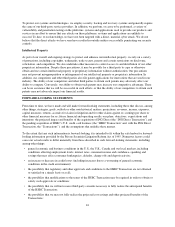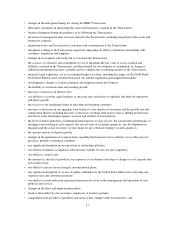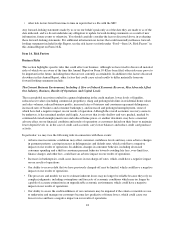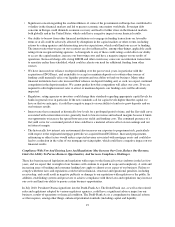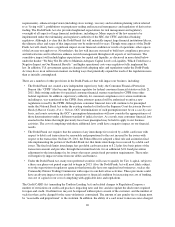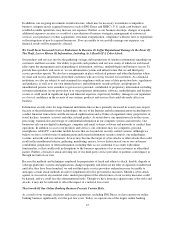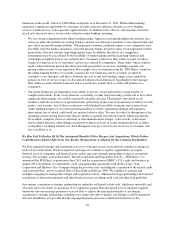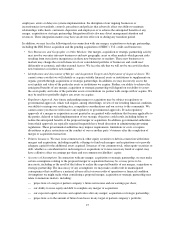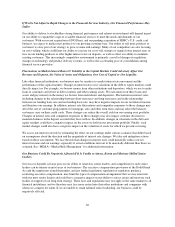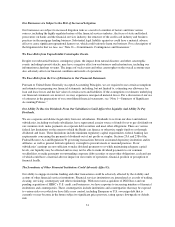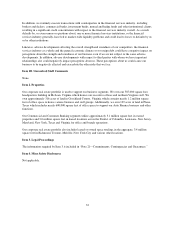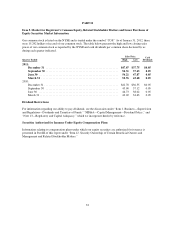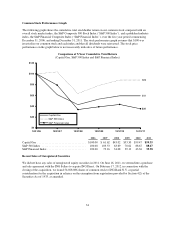Capital One 2011 Annual Report Download - page 46
Download and view the complete annual report
Please find page 46 of the 2011 Capital One annual report below. You can navigate through the pages in the report by either clicking on the pages listed below, or by using the keyword search tool below to find specific information within the annual report.businesses in the world, with over $128 billion in deposits as of December 31, 2011. While online banking
represents a significant opportunity for customers in terms of greater and more flexible access to banking
services at reduced costs, it also presents significant risks. In addition to the software, infrastructure and cyber-
attack risks discussed above, we face risks related to online banking, including:
• We face strong competition in the online banking market. Aggressive pricing throughout the industry may
adversely affect the retention of existing balances and the cost-efficient acquisition of new deposit funds and
may affect our growth and profitability. When general economic conditions improve, new competitors may
forcefully enter the market and pursue a discount pricing strategy in order to attract loan origination volume,
particularly if the new entrants target high quality loans. In addition, the effects of a competitive
environment may be exacerbated by the flexibility of online banking and the increasing financial and
technological sophistication of our customer base. Customers could close their online accounts or reduce
balances or deposits in favor of products and services offered by competitors. These shifts, which could be
rapid, could result from general dissatisfaction with our products or services, including concerns over
pricing, online security or our reputation. For example, once we transition from the “ING Direct” brand for
the online banking business we recently acquired, the new brand may not be as readily accepted by
customers as we anticipate, and these customers may not accept our branding, image, name, reputation,
policies or level of service or may be dissatisfied with perceived differences regarding how they manage
their online accounts after the transition, and as a result may transfer their accounts and business to a
competitor.
• Our online businesses are dependent on our ability to process, record and monitor a large number of
complex transactions. If any of our financial, accounting, or other data processing systems fail or have other
significant shortcomings, we could be materially adversely affected. Third parties with which we do
business could also be sources of operational risk, particularly in the event of breakdowns or failures of such
parties’ own systems. Any of these occurrences could diminish our ability to operate one or more of our
online banking businesses, or result in potential liability to clients, reputational damage and regulatory
intervention, any of which could result in a material adverse effect. We may be subject to disruptions of our
operating systems arising from events that are wholly or partially beyond our control, which may include,
for example, computer viruses or electrical or telecommunications outages, cyber-attacks, as discussed
above, natural disasters, other damage to property or physical assets or events arising from local or larger
scale politics, including terrorist acts. Such disruptions may give rise to losses in service to customers and
loss or liability to us.
We May Fail To Realize All Of The Anticipated Benefits Of Our Mergers And Acquisitions, Which Failure
Could Result in Adverse Effects On Our Results Of Operations or Dilution Of Our Common Stockholders.
We have engaged in merger and acquisition activity over the past several years and may continue to engage in
such activity in the future. We have explored, and expect to continue to explore, opportunities to acquire
financial services companies and financial assets and to enter into strategic partnerships as part of our growth
strategy. For example, as described under “Recent Acquisition and Disposition Activity—ING Direct,” we
announced the ING Direct acquisition in June 2011 and the acquisition of HSBC’s U.S. credit card business in
August 2011. In addition, we entered into credit card partnership agreements with, Kohl’s Corp., Sony
Corporation and Hudson’s Bay Company during the past two years, including the acquisition of the related credit
card loan portfolios, and we acquired Chevy Chase Bank in February 2009. We continue to evaluate and
anticipate engaging in, among other merger and acquisition activity, additional strategic partnerships and selected
acquisitions of financial institutions and other financial assets, including credit card and other loan portfolios.
Any merger, acquisition or strategic partnership we undertake will entail certain risks, which may materially and
adversely affect our results of operations. If we experience greater than anticipated costs to integrate acquired
businesses into our existing operations or are not able to achieve the anticipated benefits of any merger,
acquisition or strategic partnership, including cost savings and other synergies, our business could be negatively
affected. In addition, it is possible that the ongoing integration processes could result in the loss of key
26


